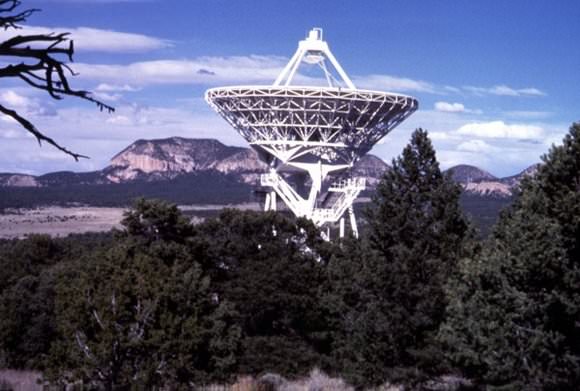[/caption]
Kitt Peak. Los Alamos. St. Croix. Pie Town.
What do these places have in common? They each house one of 10 giant telescopes in the Very Large Baseline Array, a continent-spanning collection of telescopes that’s flexing its optical muscles, reaching farther into space — with more precision — than any other telescope in the world.
And today, at the 177th annual meeting of the American Association for the Advancement of Science in Washington, DC, VLBA researchers announced an amazing feat: They’ve used the VLBA to peer, with stunning accuracy, three times as far into the universe as they had just two years ago. New measurements with the VLBA have placed a galaxy called NGC 6264 (coordinates below) at a distance of 450 million light-years from Earth, with an uncertainty of no more than 9 percent. This is the farthest distance ever directly measured, surpassing a measurement of 160 million light-years to another galaxy in 2009.

Previously, distances beyond our own Galaxy have been estimated through indirect methods. But the direct seeing power of the VLBA scraps the need for assumptions, noted James Braatz, of the National Radio Astronomy Observatory.
The VLBA provides the greatest ability to see fine detail, called resolving power, of any telescope in the world. It can produce images hundreds of times more detailed than those from the Hubble Space Telescope, at a power equivalent to sitting in New York and reading a newspaper in Los Angeles. VLBA sites include Kitt Peak, Arizona; Los Alamos and Pie Town, New Mexico; St. Croix in the Virgin Islands, Mauna Kea, Hawaii; Brewster, Washington; Fort Davis, Texas; Hancock, New Hampshire; North Liberty, Iowa; and Owens Valley in California. Sure, I could include pictures of the scopes in Hawaii or the Virgin Islands. But Pie Town, besides hosting the Very Large Array, also has two fun restaurants (the Daily Pie and the Pie-O-Neer) with really amazing pie. And an annual pie-eating festival. So it wins:

Tripling the visible “yardstick” into space bears favorably on numerous areas of astrophysics, including determining the nature of dark energy, which constitutes 70 percent of the Universe. The VLBA is also redrawing the map of the Milky Way and is poised to yield tantalizing new information about extrasolar planets, the NRAO points out.
Fine-tuning the measurement of ever-greater distances is vital to determining the expansion rate of the Universe, which helps theorists narrow down possible explanations for the nature of dark energy. Different models of Dark Energy predict different values for the expansion rate, known as the Hubble Constant.
“Solving the Dark Energy problem requires advancing the precision of cosmic distance measurements, and we are working to refine our observations and extend our methods to more galaxies,” Braatz said. Measuring more-distant galaxies is vital, because the farther a galaxy is, the more of its motion is due to the expansion of the Universe rather than to random motions.
As for the map of our own galaxy, the direct VLBA measurements are improving on earlier estimates by as much as a factor of two. The clearer observations have already revealed the Milky Way has four spiral arms, not two as previously thought.
Mark Reid, of the Harvard-Smithsonian Center for Astrophysics led an earlier VLBA study revealing that the Milky Way is also rotating faster than previously believed — and that it’s as massive as Andromeda.
Reid’s team is now observing the Andromeda Galaxy in a long-term project to determine the direction and speed of its movement through space. “The standard prediction is that the Milky Way and Andromeda will collide in a few billion years. By measuring Andromeda’s actual motion, we can determine with much greater accuracy if and when that will happen,” Reid said.
The VLBA is also being used for a long-term, sensitive search of 30 stars to find the subtle gravitational tug that will reveal orbiting planets. That four-year program, started in 2007, is nearing its completion. The project uses the VLBA along with NRAO’s Green Bank Telescope in West Virginia, the largest fully-steerable dish antenna in the world. Early results have ruled out any companions the size of brown dwarfs for three of the stars, and the astronomers are analyzing their data as the observations continue.
Ongoing upgrades in electronics and computing have enhanced the VLBA’s capabilities. With improvements now nearing completion, the VLBA will be as much as 5,000 times more powerful as a scientific tool than the original VLBA of 1993.
NGC 6264 Coordinates, from DOCdb: 16<sup>h</sup> 57<sup>m</sup> 16.08<sup>s</sup>; +27° 50′ 58.9″
Source: A press release from the National Radio Astronomy Observatory, via the American Astronomical Society (AAS). Not to be confused with the American Association for the Advancement of Science (AAAS), which now conducting its annual meeting in Washington, DC — and where the VLBA results were presented.


With a visual magnitude of 14.7 and a Blue mag. of 15.4, not an easy object, unless you have aperture to spare? A 10 inch telescope should have a limiting visual magnitude of about 14.7… on a good night!
Is there any reason we couldn’t put spacecraft with unfolding radio dishes at Earth’s leading and trailing Lagrange points? Imagine a baseline 260 million kilometres long.
I’m highly curious as to what exactly are the “direct, geometric measurements” (quoting the press release) involved here.
As far as I know, only parallax trigonometric measurements deserve to be called “direct, geometric”. The baseline for this being Earth’s orbit diameter for all observations conducted so far, it would require a _enormous_ improvement in resolution to extend the distance range as claimed.
I checked some figures: Hipparcos with 0.2-0.1 mas (milli-arc-second) precision measured distances out to about 3000 light years.
VLBA best resolution is 0.17 mas according to Wikipedia (http://en.wikipedia.org/wiki/Very_Long_Baseline_Array), at its shortest wavelength (could be useful to mention that we’re talking about radio-telescopes here).
Directly accessible distance jumps to 30000 ly. Impressive, but quite far from the claim.
Someone please explain?
Maybe they are referring to this? (From “Estimation of the Hubble Constant and Constraint on Descriptions of Dark Energy”, Greenhill et al, arxiv 2009.)
“Few direct techniques can deliver high-accuracy estimates of H0. High-angular resolution study of H2O maser sources that lie in the accretion
disks of AGN (“disk masers”) can contribute a direct, geometric measurement, built on distance estimates to individual anchor galaxies. The
strength of these estimates lies in a well-defined geometry for the underlying astrophysical system, with relatively few parameters. […] When angular and velocity structure can be resolved using Very Long Baseline Interferometry (VLBI), with sub-milliarcsecond angular resolution, it is possible to infer disk geometry and central masses (106-108 M?; Tilak et al. 2008, and references therein) with little more than Newton’s Law.” [My bold.]
Thanks! Fascinating perspectives here. I was not aware of that.
Now let’s have a few Ia supernovae in this galaxy 😉
The method employed for the distance measurements involves observations of water-vapor maser complexes that reside in circumnuclear disks very close (sub-parsec scales) to the nucleus of many AGN galaxies.
Assuming a Keplerian orbit, measuring the centripetal acceleration and velocity of water maser complexes yields the physical diameter subtended by the maser spots. By then comparing the physical radius to the angular diameter measured on the sky, the distance to the maser may be determined.
This technique was first employed in 1999 through study of NGC 4258 using VLBI. As noted in this article these new measurements are the first to explore galaxies well into the Hubble flow (~50-200 Mpc) and are part of a project to determine the value of the Hubble constant without the use of standard candles.
In addition to TLOM’s link below (thnx!), a 2010 overview of the Megamaser Cosmology Project and description of the technique by Braatz et al can be found here: http://www.nrao.edu/A2010/whitepapers/rac/Braatz_maser_cosmology_CFP.pdf
Ooops….that should be TLOMs link *above*. Somedays it’s hard to tell up from down! Must be one of those, yeah. 🙂
Thanks for the explanation, context of both measurement and current use much appreciated! (Read: I didn’t take time to read that paper, so was vague on the details.)
Great! But too bad, I was curious about how much the new direct result deviated from the old indirect, but the press release doesn’t say.
Also with a bar, visible in the artist’s conception.
It is hard to notice your own grandeur without a good mirror. I’m sure the Milky Way will become even more splendid and detailed in the future.
Of course circular radio telescopes benefit from a good valued pi!
Sorry. This is an old story rehashed probably because the Publicity Officer has little in his kit bag to highly the activities of the VLBA and/or the National Radio Astronomy Observatory,
You can read the arXiv 0902.3928v2 “Structure and Dynamics of the Milky Way: an Astro2010 Science White Paper” (2009) http://arxiv.org/abs/0902.3928 [The lead graphic, including the new measures, appears from this source, ]
Also the truth in all of this lies in the SKA, where these authors real purpose towards improvement in the Milky Way dynamics are said as; “The construction of even a 5% SKA in the Southern Hemisphere would allow exquisite mapping of the entire Milky Way. Finally, we note that the construction of the entire SKA concept would revolutionize all of these activities and lead to truly dramatic astrometric results.”
The basis, and argument here, is to upgrade the VLBA, so when it is combined with the SKA, we can get a better picture of the Milky Way. The story and press release just ignores the very reason why this story presently exist.
If you want to now about the ambitious SKA (Square Kilometre Array), the Australian program “Catalyst” gives an excellent introduction and general explanation. The video, transcript and podcast appears from http://www.abc.net.au/catalyst/stories/3141191.htm
The SKA website is also at; http://www.skatelescope.org/
There is a really excellent companion article of the Milky Way in arXiv today (23rd).
Entitled “Mass models of the Milky Way” by Paul McMillan. http://arxiv.org/abs/1102.4340 This paper gives and excellent picture of our knowledge uncertainties of various parameters of our Milky Way.
Highly recommended on the state of play of our knowledge and the need for such combining observations made by VLBA (and the future SKA.)